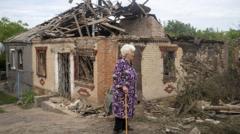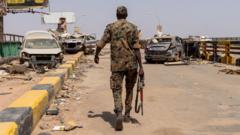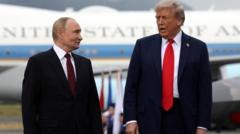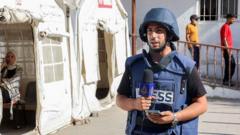The ongoing conflict in Sudan has inflicted devastating blows to the nation's museums, with the National Museum losing thousands of invaluable artefacts to looting and destruction. Officials accuse militias of deliberately targeting cultural institutions, aiming to erase Sudan's rich historical narrative.
The Cultural Holocaust: Sudan's Museums Under Siege
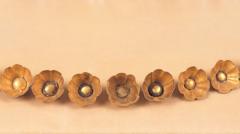
The Cultural Holocaust: Sudan's Museums Under Siege
As Sudan's war devastates its heritage, priceless artefacts are lost or plundered, signaling a grim fate for the nation's cultural identity.
The Sudan National Museum, once a treasure trove of ancient Nubian artefacts and Christian wall paintings, has been left in ruins amidst the ongoing conflict that erupted two years ago. Previously a vibrant destination for schoolchildren and tourists, the museum now stands as a testament to the devastation wrought by war. The Sudanese military's recent victories over rival forces have revealed the full extent of destruction that has befallen many cultural landmarks, with government buildings and museums heavily damaged or looted.
Ikhlas Abdel Latif Ahmed, the director of museums at Sudan's National Corporation for Antiquities and Museums, described the situation as a tragedy for Sudan's identity and history. Artifacts that told the story of Nubian rulers and civilizations have been destroyed or smuggled away during the power struggles in Khartoum, where tens of thousands are believed to have gone missing.
The once-marvelous National Museum, located near vital landmarks like the Presidential Palace and the confluence of rivers, now suffers from shattered glass, bullet casings, and the visible scars of looting. Ahmed detailed how gangs eroded the museum's core, taking many of its unique collections and rendering much of what remained irreparably damaged. Last September, UNESCO raised alarms over the imminent threat to Sudanese culture as it urged global art dealers not to facilitate the sale or trade of looted artifacts.
In its previous state, the museum was undergoing renovations, which may have inadvertently made audits easier and led to the disappearance of treasures like a gold collar from the pyramid of King Talakhamani, thought to have been taken by militia operatives to other countries, such as the United Arab Emirates. Sudan’s government plans to contact Interpol and UNESCO for the recovery of stolen items, although prospects seem dim in the face of ongoing violence.
Critics argue that the looting and destruction perpetrated by the Rapid Support Forces (RSF) represents more than mere opportunistic crime, asserting it is a strategic assault on the nation's cultural identity. Political analyst Amgad Farid of the Fikra for Studies and Development accused the RSF of a calculated attempt to dismantle Sudan’s historical legacy, aiming to profit from the destruction of invaluable heritage that spans over 7,000 years.
For the civilians of Sudan, the plight of the National Museum embodies the broader experience of displacement and loss, as nearly 13 million people have been uprooted since the conflict began. Ahmed laments the profound human and cultural toll of this war but holds strong hope for restoration. "God willing," she said, "we will recover our collections and rebuild a more magnificent museum."

